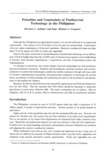Priorities and Constraints of Postharvest Technology in the Philippines
JIRCAS international symposium series
| ISSN | 13406108 |
|---|---|
| 書誌レコードID(総合目録DB) | AA1100908X |

本文フルテキスト
intlsymp-7_9-16.pdf240 KB
Although the Philippines is an agricultural country, it is not self-sufficient in its staple food requirements. The country is 5 to 10 % short of its rice and corn annual needs. It also shows a low per capita consumption of fruits and vegetables. Moreover, postharvest losses are high: about 15 % for grains and 30% for fruits and vegetables.
Some of the major constraints in the development of postharvest technology are as follows: lack of R & D budget (less than 1% of GNP), lack of infrastructure support, small landholdings of farmers, weak farmers' organizations / cooperatives, and lack of government policy and implementation.
To develop its agriculture, the country adopts improved technologies for both production and post-production operations. Research and development, training, extension and commercialization of postharvest technologies, postharvest facility assistance through soft loan credit to farmers' organizations/cooperatives, and government assistance to encourage the private sector investment in food-processing and marketing are some of the priorities in the development of the postharvest industry.
Recently, the Ramos administration has enacted the Agricultural and Fisheries Modernization Act (RA 8435). This law specifies that P120 billion should be allocated to modernize agriculture in seven years, effective 1999. The major components are as follows : 30% for irrigation, 10% for R & D, another 10% for infrastructure, and 10% for postharvest facilities.
Some of the major constraints in the development of postharvest technology are as follows: lack of R & D budget (less than 1% of GNP), lack of infrastructure support, small landholdings of farmers, weak farmers' organizations / cooperatives, and lack of government policy and implementation.
To develop its agriculture, the country adopts improved technologies for both production and post-production operations. Research and development, training, extension and commercialization of postharvest technologies, postharvest facility assistance through soft loan credit to farmers' organizations/cooperatives, and government assistance to encourage the private sector investment in food-processing and marketing are some of the priorities in the development of the postharvest industry.
Recently, the Ramos administration has enacted the Agricultural and Fisheries Modernization Act (RA 8435). This law specifies that P120 billion should be allocated to modernize agriculture in seven years, effective 1999. The major components are as follows : 30% for irrigation, 10% for R & D, another 10% for infrastructure, and 10% for postharvest facilities.
| 作成者 | Silvestre C. Andales Engr. Michael A. Gragasin |
|---|---|
| 公開者 | Japan International Research Center for Agricultural Sciences |
| オンライン掲載日 | |
| 号 | 7 |
| 開始ページ | 9 |
| 終了ページ | 16 |
| 言語 | eng |
